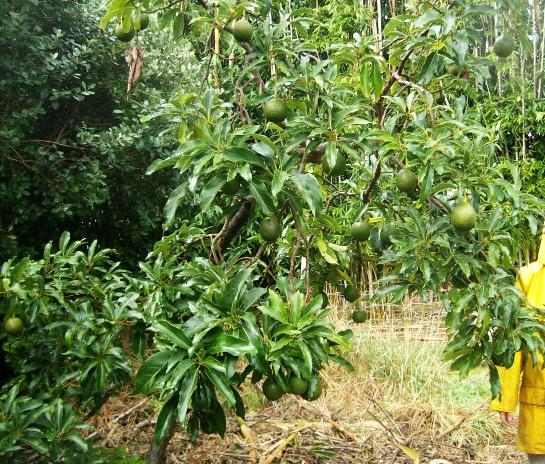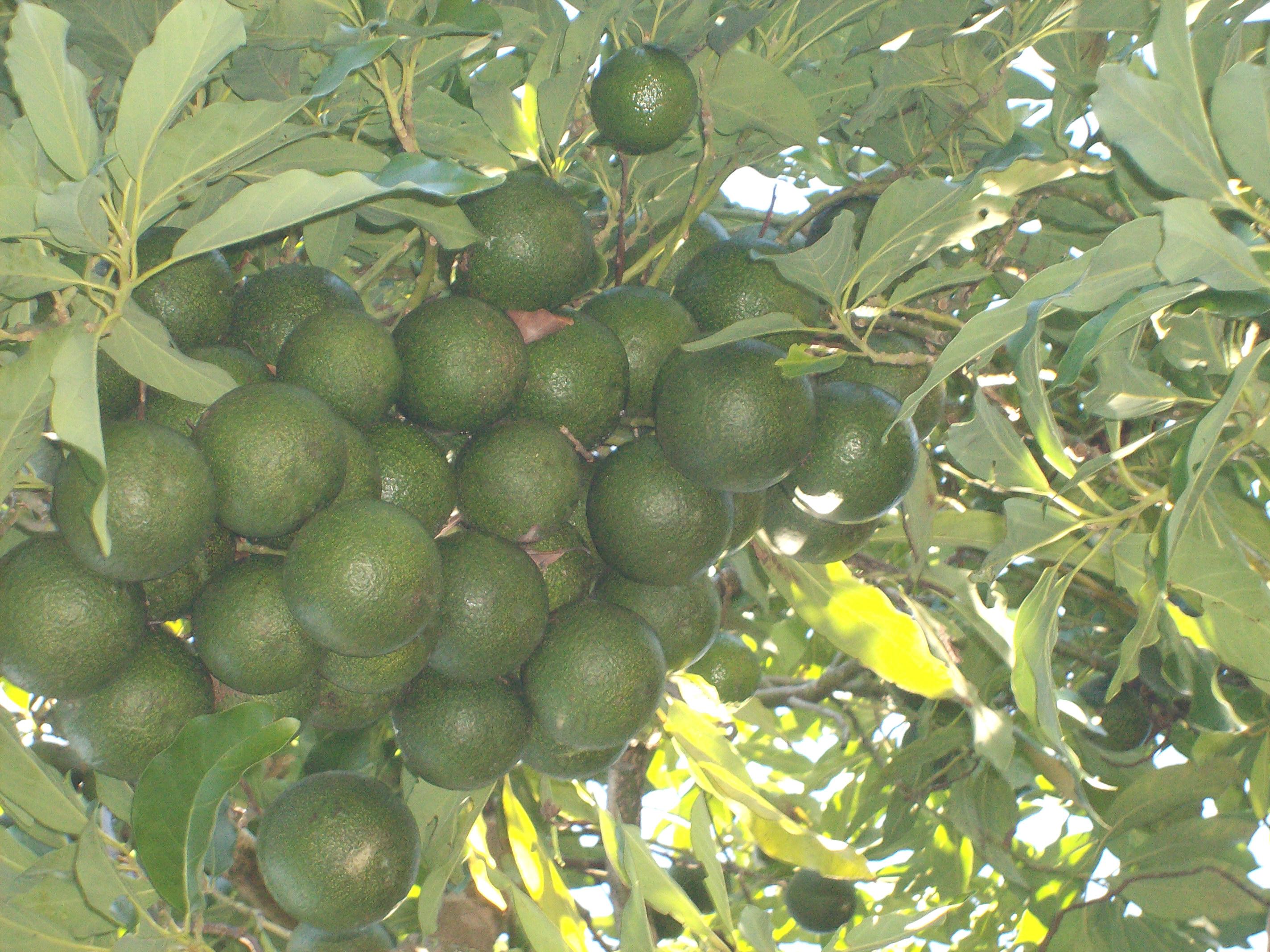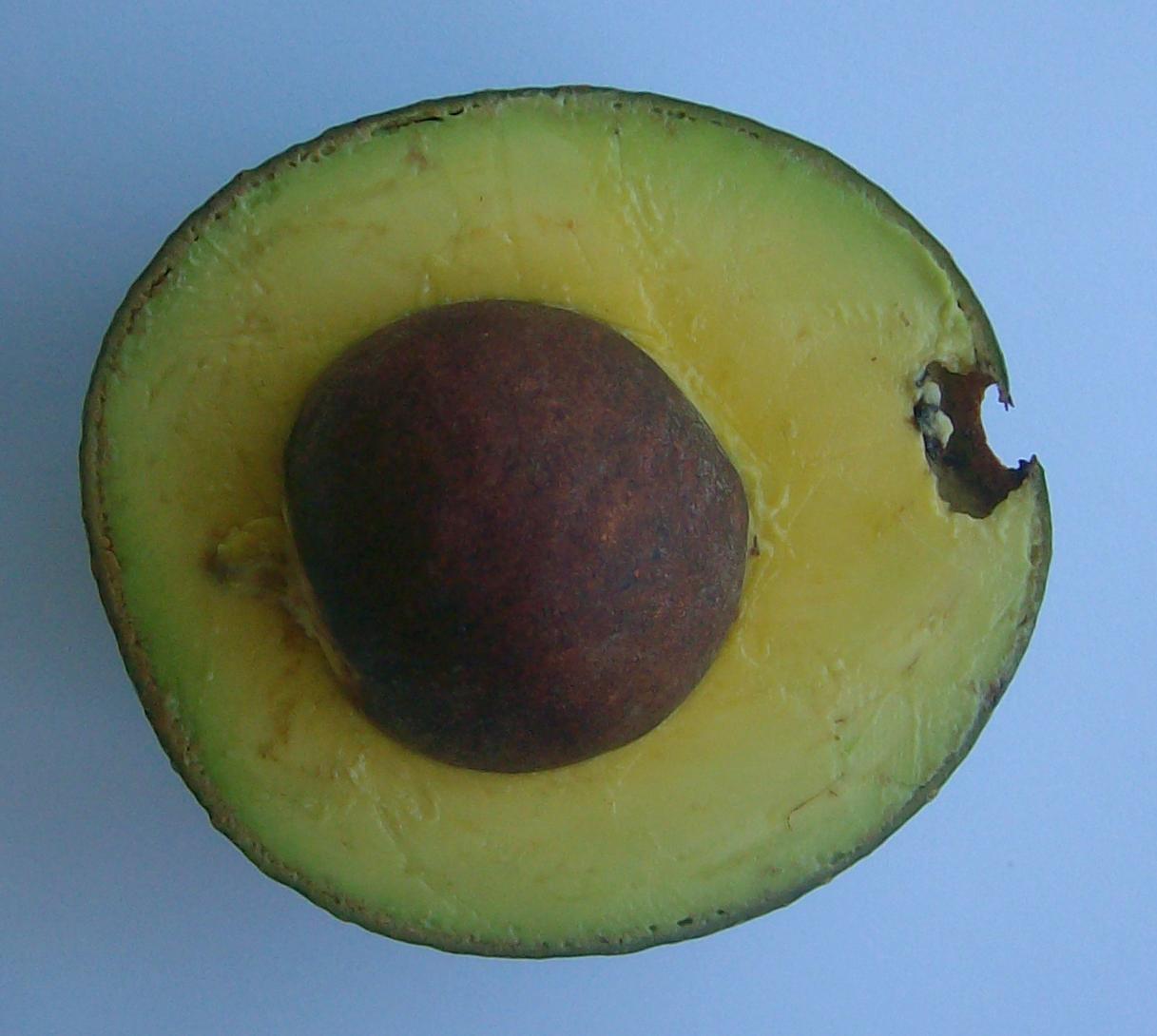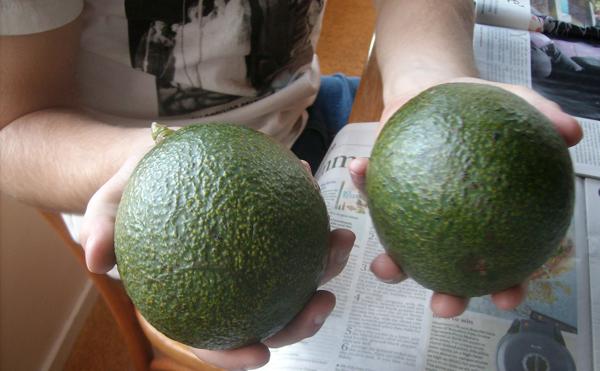by Laurie Meadows
The
Reed avocado variety is a chance seedling of Nabal, selected
by James Reed in California in 1948. The tree bears regular
crops of large, round fruit of exceptional eating quality.
The tree is vigorous and upright, but apparently can be keep to about 2.5 metres in height by intensive pruning.
We have had a tree here for many years, but it has been affected with phytophthora root rot from the start. We have kept it alive, if not thriving, by regular additions of woody material for mulch, occasional dressing of sheep poo and sheep poo liquid manure. It has had one ever treatment with phosphoric acid injected into the trunk. It is slowly becoming more vigorous, but the root disease, plus the fact that it matures 20 to 30 fruit every year has meant it has remained a very small tree - a bit taller than head height.

Our small phytophthora-affected, but reliable Reed tree (april 2011)
It is a late season green-skinned fruit, like Hellen. And like Hellen, it has a thick skin, albeit not as shell-like; but it is still hard to tell when it is ripe.
Reed is very productive. Like Hass, it has the 'A' type flowering pattern. Reed starts flowering later in spring than Hass, when the weather is warmer.

Reed fruit on a mature tree in a commercial orchard.
The flesh quality is outstanding. Some consider Reed avocado fruit as the best tasting avocado there is.

Ripe Reed fruit. Note the cavity where the stem button was 'flick tested'.
The fruit are quite large, ranging from about 240 grams to about 500 grams. Some fruit can be bigger than that.

These fruit weight 600 grams each
At Helensville, north of Auckland, their season seems to be march to april, but they will hang on the tree much longer, if the rats and possums don't get them (a few late set fruit can remain on the tree into july).
In the Bay of Plenty, where avocado take longer to ripen, and the season starts a little later, the dry matter content just before Xmas is about 20%, too low to harvest. Dry matter in the Bay doesn't reach the required levels until late february, and by late march levels are very good - from about 27% to 29%. So Reeds main season in the Bay starts in march and goes through until late june.
In Whangarei, Reed fruit harvested a few days before Christmas had dry matter content from about 20% to just over 24%. ('Avoscene', November 2015) The minimum maturity indicator for Hass is 24%, so I suppose Reed are also perfectly nice, but not spectacular, at this level. By mid January Whangarei grown Reed have reached from about 24% to 28% dry matter, and by late February they are at, or over 30% - into the spectacularly good tasting range!
Here, if the largest (and therefore most mature) fruit are picked first, some fruit can be picked in late February. In prolonged dry weather fruit will start falling in February.They can sometimes be earlier - in some years, a few larger early-set fruit will be good quality by the end of December, just in time for Xmas. But they are usually at their best from March onward. The fruit begin to fall naturally from mid April onward. Towards the end of the season, in May, the seed within the fruit starts to crack as the main root begins to grow.
At this point they are very oily and very good - but Hass at this time has a richer flavor.
But in very hot and moist years (Auckland north) they should be picked earlier, by the end of march, or they can be overmature and by end of april 'bacony'.
Picked fruit should ripen in about 5 days. One way to check ripeness is to lightly flick the piece of stem at the end of the fruit. If it falls out, the fruit is ripe. You can double check by pushing a toothpick into the cavity where the stem flicked out. If it goes in without much resistance, the fruit is ripe. Another way is to squeeze the fruit gently. An unripe fruit is hard, a ripe fruit has a little bit of 'give'. (Soft skin avocados, such as Hass, will bruise badly if you do the 'squeeze test'.)
Reed is a great cultivar for the home garden, provided it is pruned hard. Pity it is hard to tell when it has ripened.
If you have corrections, observations, or comments, feel free to drop a line to:
avocado [and next insert the symbol ["@"] lauriemeadows "dot" info. Apologies in advance, I don't check email very often, so acknowledgement may be a wee while coming.
The tree is vigorous and upright, but apparently can be keep to about 2.5 metres in height by intensive pruning.
We have had a tree here for many years, but it has been affected with phytophthora root rot from the start. We have kept it alive, if not thriving, by regular additions of woody material for mulch, occasional dressing of sheep poo and sheep poo liquid manure. It has had one ever treatment with phosphoric acid injected into the trunk. It is slowly becoming more vigorous, but the root disease, plus the fact that it matures 20 to 30 fruit every year has meant it has remained a very small tree - a bit taller than head height.
Our small phytophthora-affected, but reliable Reed tree (april 2011)
It is a late season green-skinned fruit, like Hellen. And like Hellen, it has a thick skin, albeit not as shell-like; but it is still hard to tell when it is ripe.
Reed is very productive. Like Hass, it has the 'A' type flowering pattern. Reed starts flowering later in spring than Hass, when the weather is warmer.
Reed fruit on a mature tree in a commercial orchard.
The flesh quality is outstanding. Some consider Reed avocado fruit as the best tasting avocado there is.
Ripe Reed fruit. Note the cavity where the stem button was 'flick tested'.
The fruit are quite large, ranging from about 240 grams to about 500 grams. Some fruit can be bigger than that.
These fruit weight 600 grams each
At Helensville, north of Auckland, their season seems to be march to april, but they will hang on the tree much longer, if the rats and possums don't get them (a few late set fruit can remain on the tree into july).
In the Bay of Plenty, where avocado take longer to ripen, and the season starts a little later, the dry matter content just before Xmas is about 20%, too low to harvest. Dry matter in the Bay doesn't reach the required levels until late february, and by late march levels are very good - from about 27% to 29%. So Reeds main season in the Bay starts in march and goes through until late june.
In Whangarei, Reed fruit harvested a few days before Christmas had dry matter content from about 20% to just over 24%. ('Avoscene', November 2015) The minimum maturity indicator for Hass is 24%, so I suppose Reed are also perfectly nice, but not spectacular, at this level. By mid January Whangarei grown Reed have reached from about 24% to 28% dry matter, and by late February they are at, or over 30% - into the spectacularly good tasting range!
Here, if the largest (and therefore most mature) fruit are picked first, some fruit can be picked in late February. In prolonged dry weather fruit will start falling in February.They can sometimes be earlier - in some years, a few larger early-set fruit will be good quality by the end of December, just in time for Xmas. But they are usually at their best from March onward. The fruit begin to fall naturally from mid April onward. Towards the end of the season, in May, the seed within the fruit starts to crack as the main root begins to grow.
At this point they are very oily and very good - but Hass at this time has a richer flavor.
But in very hot and moist years (Auckland north) they should be picked earlier, by the end of march, or they can be overmature and by end of april 'bacony'.
Picked fruit should ripen in about 5 days. One way to check ripeness is to lightly flick the piece of stem at the end of the fruit. If it falls out, the fruit is ripe. You can double check by pushing a toothpick into the cavity where the stem flicked out. If it goes in without much resistance, the fruit is ripe. Another way is to squeeze the fruit gently. An unripe fruit is hard, a ripe fruit has a little bit of 'give'. (Soft skin avocados, such as Hass, will bruise badly if you do the 'squeeze test'.)
Reed is a great cultivar for the home garden, provided it is pruned hard. Pity it is hard to tell when it has ripened.
If you have corrections, observations, or comments, feel free to drop a line to:
avocado [and next insert the symbol ["@"] lauriemeadows "dot" info. Apologies in advance, I don't check email very often, so acknowledgement may be a wee while coming.